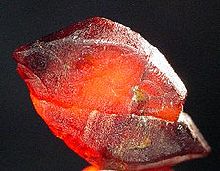- Clinohumite
-
Clinohumite 
Side View of a cushion cut clinohumite gemstone, 21.34 carats (4.27 g), 17.8 x 16 mmGeneral Category Mineral Chemical formula (Mg,Fe)9(SiO4)4(F,OH)2 Identification Color Brownish to orange, yellow, red Crystal habit Granular, prismatic, twinned Crystal system Monoclinic Cleavage Poor, basal Fracture Conchoidal to uneven Mohs scale hardness 6 Luster Vitreous to resinous Streak White Specific gravity 3.2-3.4 Refractive index 1.631–1.668 Birefringence +0.028 Pleochroism Yellow to colorless Major varieties Titanclinohumite Titanoan; (Mg,Fe2+,Ti)9[(F,OH,O)2|(SiO4)4] Clinohumite is an uncommon member of the humite group, a magnesium silicate according to the chemical formula (Mg,Fe)9(SiO4)4(F,OH)2. Most commonly found as tiny indistinct grains, large euhedral clinohumite crystals are sought by collectors and occasionally fashioned into bright, yellow-orange gemstones. Only two sources of gem-quality material are known: the Pamir Mountains of Tajikistan, and the Taymyr region of northern Siberia. It is one of two humite group minerals that have been cut into gems, the other being the much more common chondrodite.
Contents
Properties
A monoclinic mineral, clinohumite is typically a dark to light brownish or orangy yellow, somewhat resembling the hessonite variety of grossular. Clinohumite's crystal habit is usually granular, but may also be prismatic; crystals are almost always small. Simple and multiple crystal twinning (on {001}) is common, resulting in a highly variable habit. Clinohumite is brittle with a hardness of 6 and a poor basal cleavage. Its specific gravity is 3.2–3.4, and its fracture is conchoidal to uneven; its streak is white.
Clinohumite's transparency ranges from transparent to translucent; its luster ranges from a dull vitreous to resinous. Its refractive index (as measured via sodium light, 589.3 nm) is as follows: α 1.631; β 1.638–1.647; γ 1.668;, with a maximum birefringence of 0.028 (biaxial positive). Under shortwave ultraviolet light, some clinohumite may fluoresce an orangy yellow; there is little to no response under longwave UV.
The Taymyr material is reported to be a dark reddish brown while the Pamir material is a bright yellow to orange or brownish orange. The Pamir material also has a hardness slightly greater than 6, a lower specific gravity (3.18), and higher maximum birefringence (0.036). Phillip Youngman, master faceter of Los Osos, California, noticed not only that Pamir material is harder than expected, but also that it is less brittle than expected. Youngman observed that clinohumite reacted like beryl to cutting and polishing, and that it reminded him of polishing diopside.
Like other members of the humite group, the relative amounts of hydroxyl and fluorine vary in clinohumite, and iron commonly substitutes for some of the magnesium, bringing about changes in physical and optical properties. Titanium substitution also causes pronounced changes in optical properties, producing the variety titanclinohumite. Consequently, it is relatively easy to determine that a stone is a humite group mineral, but difficult to determine exactly which member. Other common impurities of clinohumite include aluminium, manganese, and calcium.
Formation and occurrence
Clinohumite is a product of contact metamorphism and is commonly found as indistinct grains embedded in limestone. Its type occurrence is within the limestone ejecta of the Mount Vesuvius volcano complex near Naples, Italy, where clinohumite was discovered in 1876. The aforementioned gem-quality occurrences of Pamir and Taymyr were discovered only recently: the former in the early 1980s, and the latter in 2000. These deposits are scarce and only sporadically mined, so clinohumite remains one of the rarest gemstones with only a few thousand carats known to exist in private collections.
Other (non-gem quality) occurrences of clinohumite include: the Sør Rondane and Balchen Mountains of Antarctica; Mount Bischoff, Waratah, Tasmania; the Saualpe Mountains of Carinthia, the Koralpe mountains of Styria, and the Vals, Virgen, and Ziller valleys of the Tyrol, Austria; the Jacupiranga mine of Cajati, São Paulo State, Southeast Region, Brazil; the Pirin Mountains of Bulgaria; Bancroft, Ontario, Notre Dame du Laus, Wakefield, and Villedieu Township, Quebec, Canada; Southern and Western Finland; Bavaria and Saxony, Germany; eastern Greenland; Ambasamudram in Tamil Nadu, India; Honshū, Japan; Suan, North Korea; Nordland, Norway; KwaZulu-Natal and Northern Cape Province, South Africa; Andalusia, Spain; Värmland and Västmanland, Sweden; Isle of Skye, Scotland; and the states of California, Colorado, Massachusetts, New Jersey, New Mexico, New York, Oklahoma, Utah, and Washington, USA.
Clinohumite also occurs as a minor component of some masses of peridotite from the Earth's mantle emplaced into the Earth's crust and as a very rare component of peridotite xenoliths. These occurrences and implications have been summarized by Luth (2003) in a discussion of the possible importance of the mineral as a significant reservoir of water in the Earth's mantle. Titanium is a minor constituent of clinohumite in most such occurrences.
See also
- Jerrygibbsite
- Chondrodite
- Alleghanyite
- Humite
References
- Arem, Joel E. (1977). Color encyclopedia of gemstones. Van Nostrand Reinhold Company, New York, 149 pages
- Deer, W.A., R.A. Howie, and J. Zussman. (1966). An introduction to the rock forming minerals. Longsman, Green and Co., Ltd., London, 528 pages.
- Henn, U., Hyršl, J., and Milisenda, C. (2000). Gem-quality clinohumite from Tajikistan and the Taymyr region, Northern Siberia. Journal of Gemmology, Vol. 27, No. 6, pp. 335–340.
- Luth, R. W. (2003) Mantle Volatiles -- Distribution and Consequences. In The Mantle and Core (ed. R. W. Carlson) Vol. 2 Treatise on Geochemistry (eds. H. D. Holland and K. K. Turekian), Elsevier-Pergamon, Oxford.ISBN 0-08-043751-6
- Mindat.org. Clinohumite. Retrieved May 9, 2005 from http://www.mindat.org/min-1077.html
- Pradeepkumar, A P., Krishnanath, R. (2000). A Pan-African 'Humite Epoch' in East Gondwana: implications for Neoproterozoic Gondwana geometry. Journal of Geodynamics, Vol. 29, No. 1-2, pp. 43-62 [1].
- Roberts, W.L., G.R. Rapps, Jr., and J. Weber. (1975). Encyclopedia of minerals. Van Nostrand Reinhyold Company, New York, 693 pages.
- Webster, R., Read, P. G. (Ed.) (2000). Gems: Their sources, descriptions and identification (5th ed.), p. 327. Butterworth-Heinemann, Great Britain. ISBN 0-7506-1674-1
Categories:- Magnesium minerals
- Iron minerals
- Gemstones
- Humite group
Wikimedia Foundation. 2010.

